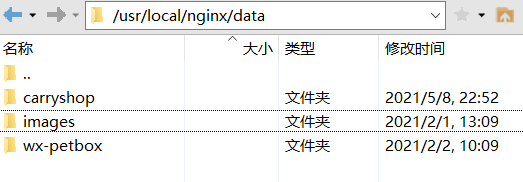Nginx部署前端项目
首先当然是检查Nginx:查看nginx的安装路径:whereis nginxnginx: /usr/local/nginxnginx常用命令:cd /usr/local/nginx/sbin./nginx./nginx -s stop./nginx -s quit安全退出./nginx -s reload重新加载配置文件ps aux | grep nginxnginx展示图片:location
安装nginx
在安装nginx前首先要确认系统中安装了gcc、pcre-devel、zlib-devel、openssl-devel。
Linux下检查是否安装过某软件包:http://www.cnblogs.com/xxoome/p/5866553.html
安装命令:
yum -y install gcc pcre-devel zlib-devel openssl openssl-devel
解压:tar -zxvf nginx-1.18.0.tar.gz
进入nginx的目录:`cd nginx-1.18.0`
执行命令配置:./configure --prefix=/usr/local/nginx
开始安装
make & make install
然后nginx就简单安装成功了;
下面是配置nginx做图片服务器的简单应用:(是在/usr/local/nginx/data里面放图片文件夹的)
mkdir /usr/local/nginx/data
修改Nginx的配置文件
查看nginx的安装路径:whereis nginx
nginx: /usr/local/nginx
接下来,就是修改nginx的配置文件,比如我的就是在解压之后的文件夹里:/usr/local/nginx/conf里面的nginx.conf文件。
注意
/root/nginx-1.18.0/conf里面也有nginx.conf文件。不过这里不是配置那个文件。
nginx展示图片:
location /images {
root /usr/local/nginx/data; # 文件放在/usr/local/nginx/data/images下面
autoindex on;
}
location /www {
alias /usr/local/nginx/data/www;
autoindex on;
}
这样修改配置之后,就可以通过则访问的时候就是:http://ip:80/images/library.jpg
举例如下:
加上配置信息:
location /carryshop {
root /usr/local/nginx/data;
index index.html;
}
把前端项目打包:npm run build ;
然后会生成dist文件夹;
这里我先把文件夹重命名为carryshop,然后上传如图:

重启nginx;
只要文件对应成功,就是可以访问的啦!
附上nginx的配置:
#user nobody;
worker_processes 1;
#error_log logs/error.log;
#error_log logs/error.log notice;
#error_log logs/error.log info;
#pid logs/nginx.pid;
events {
worker_connections 1024;
}
http {
include mime.types;
default_type application/octet-stream;
#log_format main '$remote_addr - $remote_user [$time_local] "$request" '
# '$status $body_bytes_sent "$http_referer" '
# '"$http_user_agent" "$http_x_forwarded_for"';
#access_log logs/access.log main;
sendfile on;
#tcp_nopush on;
#keepalive_timeout 0;
keepalive_timeout 65;
gzip on;
#设置压缩最小单位,小于不压缩
gzip_min_length 1k;
#gzip_disable "msie6";
# gzip_vary on;
# gzip_proxied any;
gzip_comp_level 4; # 压缩比
gzip_buffers 4 16k;
gzip_http_version 1.1;
gzip_types text/plain text/css application/json application/javascript text/xml application/xml application/xml+rss text/javascript; # 压缩内容
server {
listen 80;
server_name localhost;
#charset koi8-r;
#access_log logs/host.access.log main;
location / {
root html;
index index.html index.htm;
}
location /wx-petbox {
root /usr/local/nginx/data;
}
location /carryshop {
root /usr/local/nginx/data;
index index.html;
}
location /www {
alias /usr/local/nginx/data/www;
autoindex on;
}
#error_page 404 /404.html;
# redirect server error pages to the static page /50x.html
#
error_page 500 502 503 504 /50x.html;
location = /50x.html {
root html;
}
# proxy the PHP scripts to Apache listening on 127.0.0.1:80
#
#location ~ \.php$ {
# proxy_pass http://127.0.0.1;
#}
# pass the PHP scripts to FastCGI server listening on 127.0.0.1:9000
#
#location ~ \.php$ {
# root html;
# fastcgi_pass 127.0.0.1:9000;
# fastcgi_index index.php;
# fastcgi_param SCRIPT_FILENAME /scripts$fastcgi_script_name;
# include fastcgi_params;
#}
# deny access to .htaccess files, if Apache's document root
# concurs with nginx's one
#
#location ~ /\.ht {
# deny all;
#}
}
# another virtual host using mix of IP-, name-, and port-based configuration
#
#server {
# listen 8000;
# listen somename:8080;
# server_name somename alias another.alias;
# location / {
# root html;
# index index.html index.htm;
# }
#}
# HTTPS server
#
#server {
# listen 443 ssl;
# server_name localhost;
# ssl_certificate cert.pem;
# ssl_certificate_key cert.key;
# ssl_session_cache shared:SSL:1m;
# ssl_session_timeout 5m;
# ssl_ciphers HIGH:!aNULL:!MD5;
# ssl_prefer_server_ciphers on;
# location / {
# root html;
# index index.html index.htm;
# }
#}
}
上传配置文件之后,进行重启操作
nginx常用命令:
cd /usr/local/nginx/sbin
./nginx
./nginx -s stop
./nginx -s quit 安全退出
./nginx -s reload 重新加载配置文件
ps aux | grep nginx
nginx 配置 https
首先要在阿里云上下载证书:《SSL证书》

然后点击免费证书,找到自己对应域名的的免费证书,进行下载。
如图:把自己的.pem文件和.key文件放在/usr/local/nginx/conf目录下:

开始编写nginx的配置文件nginx.conf:
报了错:
nginx: [emerg] the “ssl” parameter requires ngx_http_ssl_module in /usr/local/nginx/conf/nginx.conf:117
您需要重新编译Nginx并在编译安装的时候加上–with-http_ssl_module配置。
找到nginx-1.18.0文件夹,执行命令`./configure --prefix=/usr/local/nginx --with-http_stub_status_module --with-http_ssl_module
可以参考 : https://www.cnblogs.com/ghjbk/p/6744131.html
注意在执行cp指令的时候要输入y , 我就是因为每次执行到那一步的时候,直接使用了回车,导致每次都失败了。
最后附上我的nginx.conf:
#user nobody;
worker_processes 1;
#error_log logs/error.log;
#error_log logs/error.log notice;
#error_log logs/error.log info;
#pid logs/nginx.pid;
events {
worker_connections 1024;
}
http {
include mime.types;
default_type application/octet-stream;
#log_format main '$remote_addr - $remote_user [$time_local] "$request" '
# '$status $body_bytes_sent "$http_referer" '
# '"$http_user_agent" "$http_x_forwarded_for"';
#access_log logs/access.log main;
sendfile on;
#tcp_nopush on;
#keepalive_timeout 0;
keepalive_timeout 65;
#gzip on;
gzip on;
gzip_min_length 1k;
#gzip_disable "msie6";
# gzip_vary on;
# gzip_proxied any;
gzip_comp_level 4;
gzip_buffers 4 16k;
gzip_http_version 1.1;
gzip_types text/plain text/css application/json application/javascript text/xml application/xml application/xml+rss text/javascript;
server {
listen 80;
server_name www.自己的域名;
location / {
root html;
index index.html index.htm;
}
rewrite ^(.*)$ https://$host$1; # 把http强制跳到https
location /wx-petbox {
root /usr/local/nginx/data;
}
location /carryshop {
root /usr/local/nginx/data;
index index.html;
}
location /star {
root /usr/local/nginx/data;
index index.html;
}
#error_page 404 /404.html;
# redirect server error pages to the static page /50x.html
#
error_page 500 502 503 504 /50x.html;
location = /50x.html {
root html;
}
# proxy the PHP scripts to Apache listening on 127.0.0.1:80
#
#location ~ \.php$ {
# proxy_pass http://127.0.0.1;
#}
# pass the PHP scripts to FastCGI server listening on 127.0.0.1:9000
#
#location ~ \.php$ {
# root html;
# fastcgi_pass 127.0.0.1:9000;
# fastcgi_index index.php;
# fastcgi_param SCRIPT_FILENAME /scripts$fastcgi_script_name;
# include fastcgi_params;
#}
# deny access to .htaccess files, if Apache's document root
# concurs with nginx's one
#
#location ~ /\.ht {
# deny all;
#}
}
# another virtual host using mix of IP-, name-, and port-based configuration
#
#server {
# listen 8000;
# listen somename:8080;
# server_name somename alias another.alias;
# location / {
# root html;
# index index.html index.htm;
# }
#}
# HTTPS server
server {
listen 443 ssl;
server_name www.自己的域名;
root html;
index index.html index.htm;
ssl_certificate cert/你的证书.pem;
ssl_certificate_key cert/你的证书.xyz.key;
ssl_session_timeout 5m;
ssl_ciphers ECDHE-RSA-AES128-GCM-SHA256:ECDHE:ECDH:AES:HIGH:!NULL:!aNULL:!MD5:!ADH:!RC4;
ssl_protocols TLSv1 TLSv1.1 TLSv1.2; #表示使用的TLS协议的类型。
ssl_prefer_server_ciphers on;
location / {
root html; #站点目录。
index index.html index.htm;
}
# 这里使用了NGINX的反向代理。
# 跳转到的后台地址
location /carryshopApi {
proxy_set_header X-Forwarded-For $proxy_add_x_forwarded_for;
proxy_set_header Host $http_host;
proxy_set_header X-Forwarded-Proto https;
proxy_set_header X-Forwarded-Host $host;
proxy_set_header X-Forwarded-Server $host;
proxy_redirect off;
proxy_connect_timeout 240;
proxy_send_timeout 240;
proxy_read_timeout 240;
# note, there is not SSL here! plain HTTP is used
proxy_pass http://127.0.0.1:8081/;
#后端的接口地址 这前端跳转时候的路径就是https://你的域名/carryshopApi (注意不要端口号了!这里的端口号就是443)
}
location /wx-petbox {
root /usr/local/nginx/data;
}
location /carryshop {
root /usr/local/nginx/data;
index index.html;
}
location /star {
root /usr/local/nginx/data;
index index.html;
}
}
}
本来还以为要配置springboot的https请求的,不然前后端对接时会有这种错误:

大概的意思就是前端是用哪个了https访问的页面,但是请求的后端地址是http请求的,因此就无法访问正常。解决方法就是可以使用nginx的反向代理,用代理跳转到springboot后端的请求。
更多推荐
 已为社区贡献2条内容
已为社区贡献2条内容










所有评论(0)